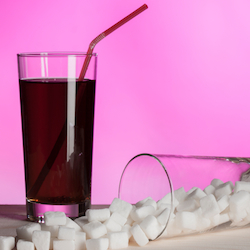Diabetes
The Sugar Solution by JJ Virgin
In this video, JJ Virgin introduces a new way to rate sugar based on its impact on the body, expanding on her concept that the body isn’t a bank account, it’s a chemistry lab, and food sends powerful chemical messages. Sugar is finally getting the attention it deserves. Following inRead
Personalized Nutrition and Metabolic Response
As you sit down to a dinner with family and friends you can learn a lot about the unique aspects of your tablemates’ metabolic response. Uncle Joe’s blood sugar may rise more from mashed potatoes than from Aunt Sue’s apple pie. But for your own blood sugar, the results couldRead
Link Between Artificial Sweeteners and Diabetes
Pink, yellow, or blue? Each of these non-caloric sweeteners may be contributing to the global epidemic of diabetes. The study published in Nature today (Sept. 17, 2014), shows the non-nutritive sweeteners, saccharin, sucralose and aspartame, could actually hasten the development of glucose intolerance and metabolic disease. The mechanism is surprising: these no-calorie sweeteners change the composition and function of gut microbiota. The researchers found the results so compelling they went so far as to call for a reassessment of non-nutritive sweeteners. By Eran Segal, Eran Elinav, published in Nature, Sept. 17, 2014.
Hispanic Men Most Affected by Diabetes Epidemic
Close to half (40%) of the adult population of the USA is expected to develop type 2 diabetes at some point during their lifetime, suggests a major study published in The Lancet Diabetes & Endocrinology. The future looks even worse for some ethnic minority groups, with one in two (> 50%) Hispanic men and women and non-Hispanic black women predicted to develop the disease. A team of US researchers combined data from nationally representative US population interviews and death certificates for about 600 000 adults to estimate trends in the lifetime risk of diabetes and years of life lost to diabetes in the USA between 1985 and 2011.
Integrating Diet and Physical Activity in Type-2 Diabetes Therapy to Reduce Inflammation
Apathy Aside, Six Factors to Reducing Global Health Risks
The biggest threat to global health and wellness can be narrowed down to six, preventable non-communicable diseases: respiratory illness from tobacco use, harmful alcohol use, salt intake, high blood pressure and blood sugar, and obesity. According to a May 2014 Lancet study, if nations could reduce target levels for these lifestyle related diseases in the next 25 years, 37 million early deaths would be prevented. But by not reaching these targets, an additional 10.5 million deaths would occur as compared to the 28.3 million who died in 2010. And while experts say this could be possible, critics say apathy from leadership is the biggest obstacle to achieving the desired target.
Google’s new contact lens measures blood sugar
Drug-Induced Nutrient Depletions and Diabetic Therapy from Jim LaValle, CCN, RPh
A challenge facing heath care professionals in treating the pre-diabetic and diabetic patient today is the problem of complications arising from polypharmacy prescribing and resulting drug-induced metabolic imbalances. With approximately 48% of people in the United States taking prescription medications…
Detoxification Diets for Symptom Relief and Weight Loss
Detoxification has become a popular option for patients to lose weight, and more importantly start a plan to improve overall health. This study examines how a carefully designed meal replacement, low-calorie detox plan, based on a questionnaire designed by Jeffrey Bland PhD, appears to be a viable option for both weight loss and reducing chronic symptoms. By Jeffrey A. Morrison, MD, CNS; Anita L. Iannucci, PhD, published in Integrative Medicine, Integrative Medicine, A Clinician’s Journal.











